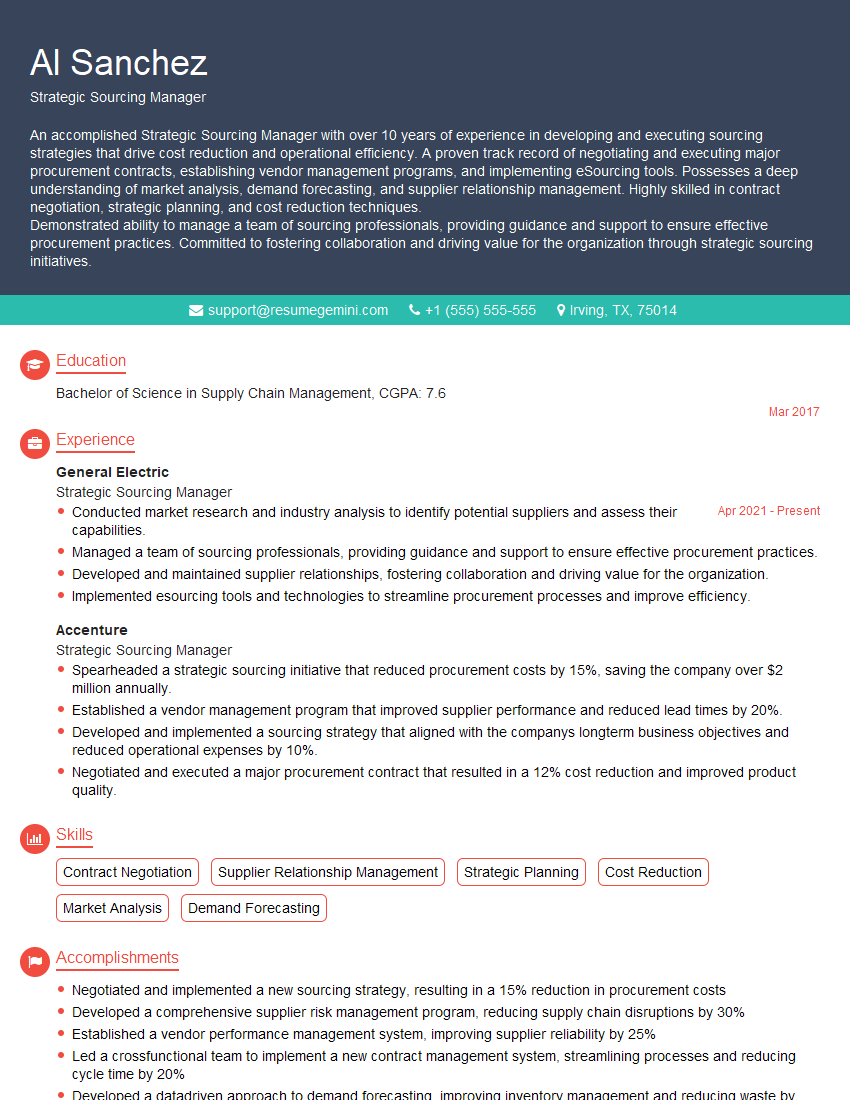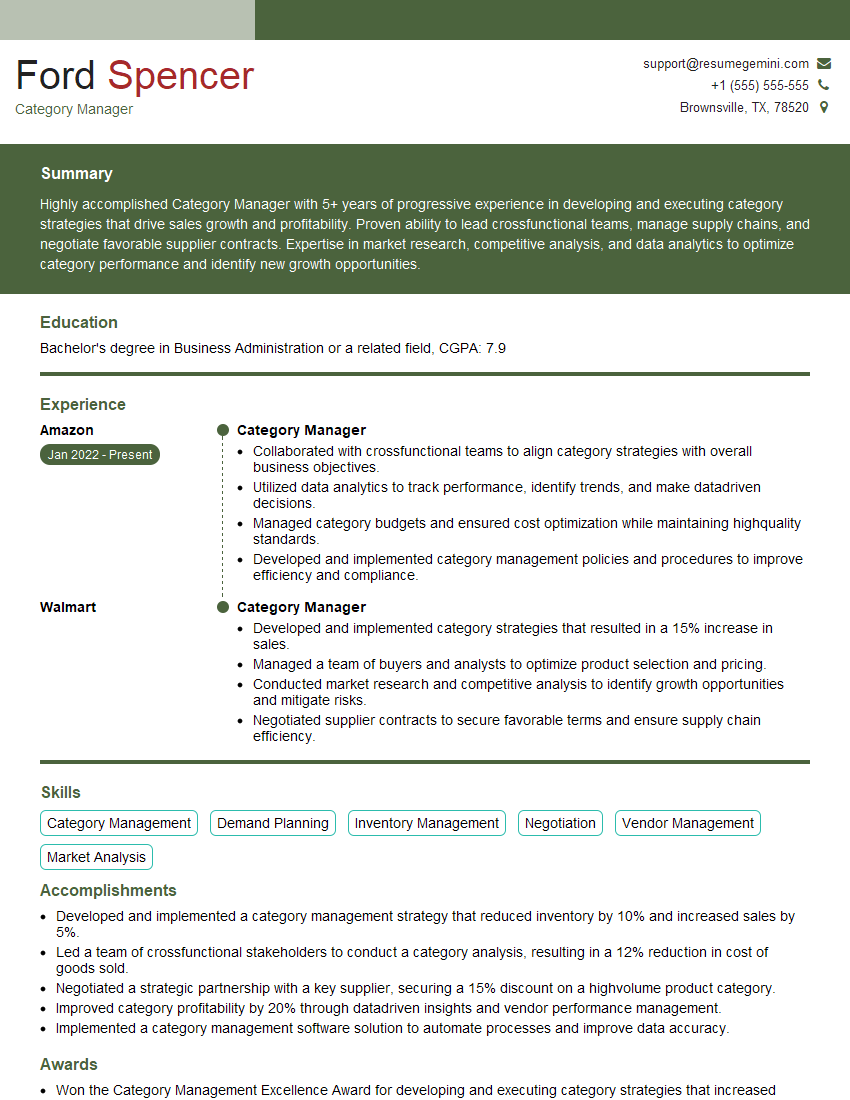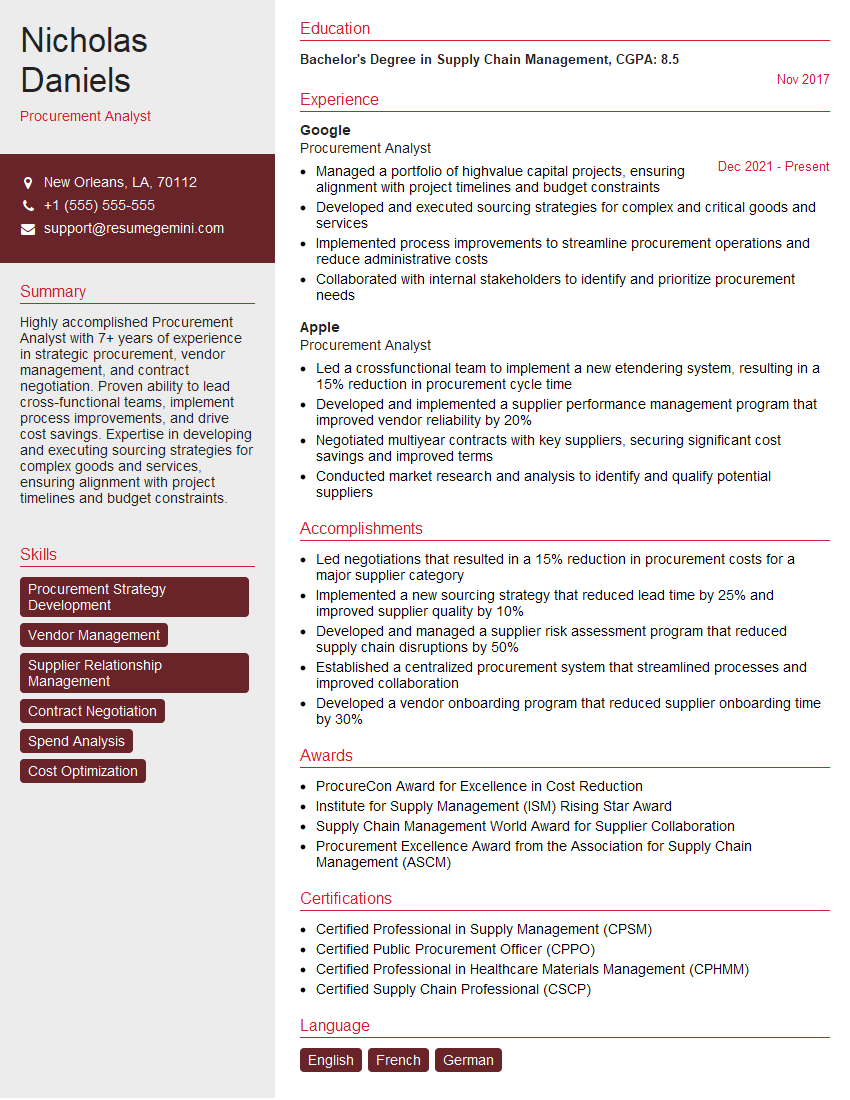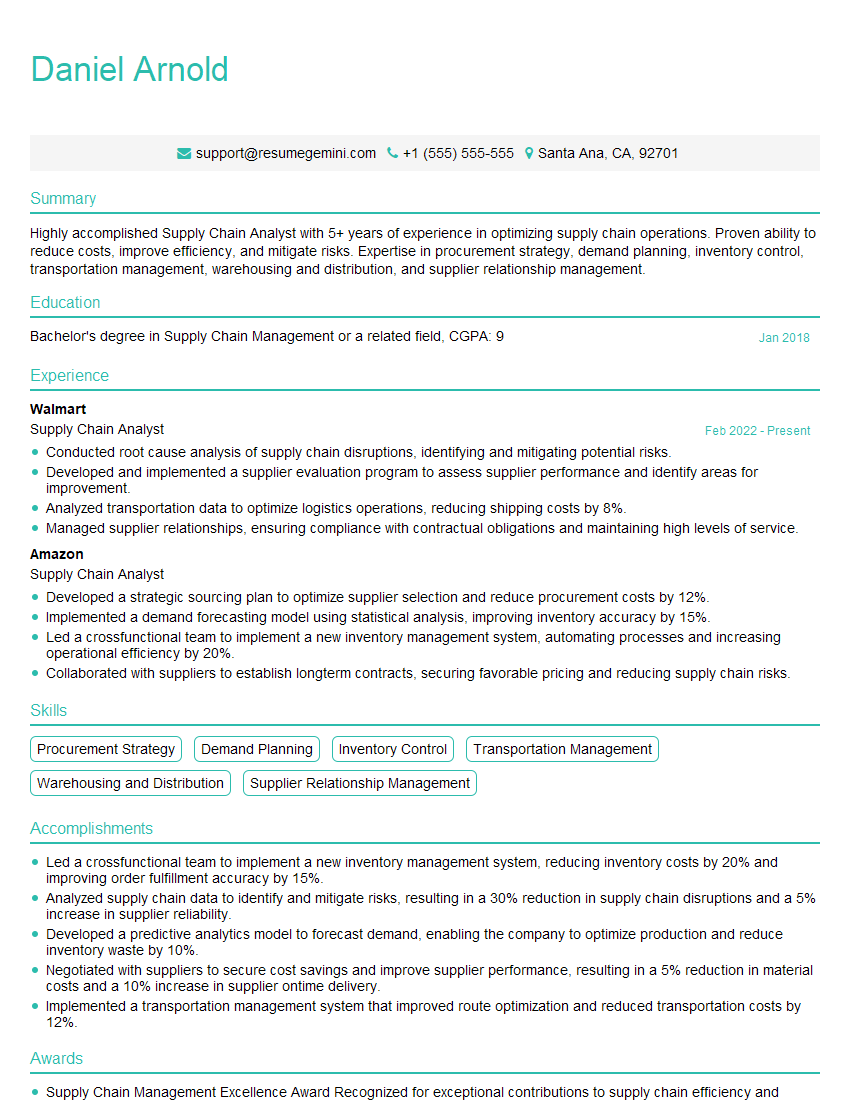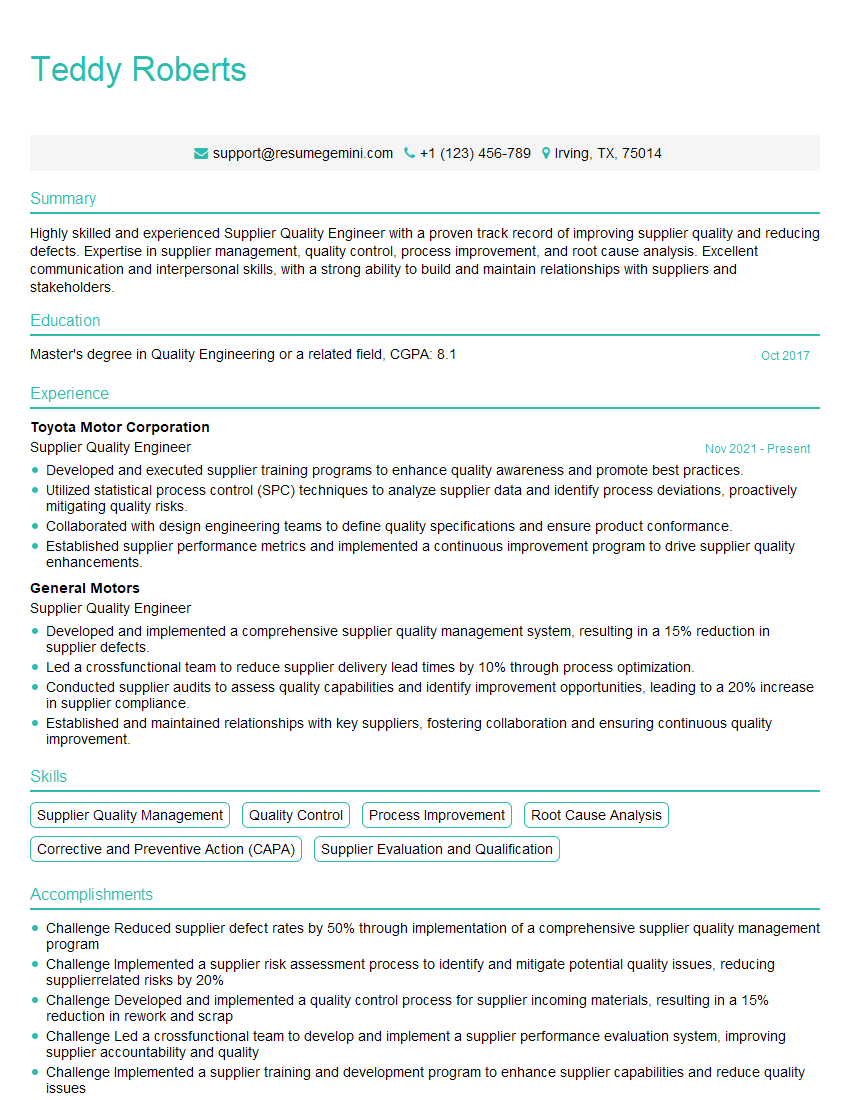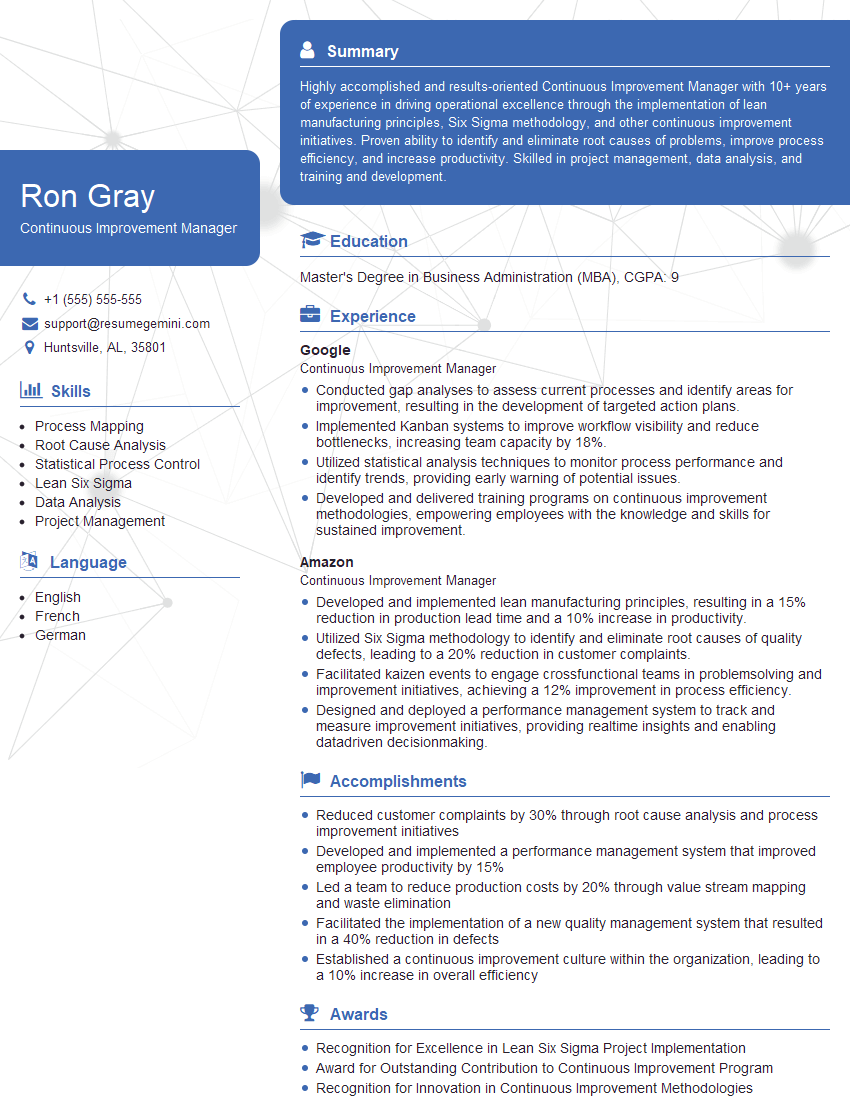Interviews are more than just a Q&A session—they’re a chance to prove your worth. This blog dives into essential Supplier Improvement Programs interview questions and expert tips to help you align your answers with what hiring managers are looking for. Start preparing to shine!
Questions Asked in Supplier Improvement Programs Interview
Q 1. Describe your experience implementing a supplier improvement program.
Implementing a successful supplier improvement program requires a structured approach, combining strategic planning with hands-on collaboration. In my previous role at Acme Manufacturing, we faced significant challenges with inconsistent quality from our key component supplier. Our program began with a comprehensive assessment of the supplier’s capabilities, identifying their strengths and weaknesses through on-site audits and data analysis. We then collaboratively defined clear improvement goals, focusing on reducing defect rates and improving lead times. This involved providing technical assistance, training their personnel on new methodologies like Six Sigma, and establishing a robust performance monitoring system. We also implemented a tiered incentive program, rewarding them for meeting and exceeding targets. The results were remarkable: a 75% reduction in defect rates within six months and a 20% reduction in lead times within a year. This success stemmed from establishing trust, fostering open communication, and aligning our interests with the supplier’s success.
Q 2. What key performance indicators (KPIs) do you track to measure supplier performance?
Key Performance Indicators (KPIs) are crucial for tracking supplier performance and driving improvement. The specific KPIs will vary depending on the industry and the nature of the supplied goods or services. However, some common and effective KPIs include:
- On-time delivery performance: Measured as a percentage of orders delivered on or before the agreed-upon date. This is a fundamental indicator of reliability.
- Quality performance: This could encompass several metrics, such as defect rate (percentage of defective parts), return rate (percentage of parts returned due to defects), or PPM (parts per million) defects.
- Lead time: The time taken from order placement to delivery. Shorter lead times improve efficiency and responsiveness.
- Cost performance: This could include metrics like unit cost, total cost of ownership, or cost reduction compared to previous periods.
- Compliance rate: The percentage of times a supplier adheres to specified regulations, contractual obligations, and ethical standards.
Regularly monitoring these KPIs allows for early identification of potential issues and proactive intervention.
Q 3. How do you identify and prioritize areas for supplier improvement?
Identifying and prioritizing areas for supplier improvement often involves a multi-faceted approach. I typically begin with a thorough data analysis, reviewing historical performance data on KPIs like those mentioned earlier. This helps pinpoint areas where the supplier consistently underperforms. Next, I conduct on-site assessments and collaborative workshops with the supplier to gain a deeper understanding of their processes and challenges. This might involve reviewing their quality management systems, analyzing their production flow, and identifying bottlenecks. A Pareto analysis can be extremely helpful here, focusing on the ‘vital few’ issues contributing to the majority of problems. Finally, we prioritize improvement areas based on their impact on our business and the feasibility of achieving improvements. Issues with the highest impact and the greatest potential for rapid improvement are tackled first.
Q 4. Explain your approach to root cause analysis in a supplier-related issue.
My approach to root cause analysis for supplier-related issues relies on a structured methodology, such as the ‘5 Whys’ technique or a fishbone diagram (Ishikawa diagram). Let’s say we’re experiencing a high defect rate in a particular component. Instead of simply addressing the symptoms, we systematically delve deeper. Using the ‘5 Whys’, we might ask:
- Why are there so many defective parts? (Answer: Poor inspection process)
- Why is the inspection process poor? (Answer: Inadequate training for inspectors)
- Why is the inspector training inadequate? (Answer: Lack of a formal training program)
- Why is there no formal training program? (Answer: Insufficient budget allocation)
- Why is the budget insufficient? (Answer: Lack of prioritisation of quality improvement)
This process helps us identify the underlying systemic issues rather than just treating the surface-level problems. We then focus our improvement efforts on addressing the root cause—in this case, the lack of prioritization of quality improvement and inadequate budget allocation—leading to more sustainable and lasting solutions.
Q 5. What methods do you use to motivate suppliers to improve performance?
Motivating suppliers to improve performance requires a blend of strategies, moving beyond simple penalties. I believe in creating a collaborative and mutually beneficial relationship. Firstly, transparent communication is key. We openly share performance data and collaboratively set realistic, achievable goals. We also provide support and resources where needed, offering training, technical assistance, and even financial incentives for achieving specific milestones. A tiered reward system, offering escalating benefits for progressively better performance, is highly effective. Furthermore, recognizing and celebrating successes—both large and small—is crucial for maintaining motivation and reinforcing positive behaviors. Building strong, long-term relationships based on trust and mutual respect is arguably the most powerful motivator of all.
Q 6. How do you handle supplier non-compliance?
Handling supplier non-compliance requires a structured approach that balances firmness with fairness. The first step is to clearly understand the nature and severity of the non-compliance. We meticulously document the breach, gathering evidence and clearly outlining the specific contractual obligations that have been violated. Then, we engage in open communication with the supplier, understanding their perspective and seeking a collaborative solution. Depending on the severity, this could involve a corrective action plan with clear deadlines and milestones. If the non-compliance is minor and rectifiable, we might offer support and guidance. However, for serious or repeated violations, we might consider implementing consequences, such as temporary suspension of business or even contract termination. The goal is to ensure compliance while preserving the supplier relationship where possible. A clear escalation process, outlining the steps involved in escalating the issue, helps to ensure a fair and consistent response.
Q 7. Describe your experience using data analytics to drive supplier improvement.
Data analytics plays a vital role in driving supplier improvement. In my experience, we leveraged data analytics to gain deep insights into supplier performance, identifying trends and patterns that might otherwise be missed. For example, we used advanced analytics to analyze historical data on defect rates, correlating them with various factors like production batch size, raw material quality, and environmental conditions. This allowed us to predict potential quality issues proactively and implement preventative measures. We also used predictive modelling to forecast future performance, helping us to identify suppliers at risk of underperforming and tailor our support accordingly. The visualizations generated from this data—dashboards showing key KPIs, trend charts, and correlation matrices—made it much easier to communicate performance issues and improvement opportunities to both internal and external stakeholders.
Q 8. What is your experience with different supplier improvement methodologies (e.g., Lean, Six Sigma)?
My experience spans various supplier improvement methodologies, primarily Lean and Six Sigma. Lean focuses on eliminating waste in all forms – from excess inventory to unnecessary steps in the production process. I’ve utilized Lean tools like Value Stream Mapping to identify and eliminate bottlenecks in supplier operations, resulting in faster lead times and reduced costs for a major automotive parts supplier. For example, by mapping the entire process of a specific component’s production, we identified a significant delay in the quality inspection stage. Implementing a faster, more efficient inspection system, utilizing poka-yoke (error-proofing) techniques, reduced lead time by 15%.
Six Sigma, on the other hand, employs a data-driven approach to reduce variation and defects. I’ve applied DMAIC (Define, Measure, Analyze, Improve, Control) methodology to improve the consistency of a printed circuit board supplier’s output. Through rigorous data analysis, we pinpointed the root cause of inconsistent soldering quality to be variations in temperature control within their reflow ovens. Implementing a new temperature monitoring and control system significantly reduced defects, improving their yield rate by 12%.
In addition to Lean and Six Sigma, I’m also familiar with other methodologies like Kaizen (continuous improvement) and 5S (sort, set in order, shine, standardize, sustain), often integrating them synergistically for comprehensive supplier improvement.
Q 9. How do you build and maintain strong relationships with suppliers?
Building strong supplier relationships is crucial for successful improvement initiatives. I believe in open communication, transparency, and mutual respect. It’s not just about transactional relationships; it’s about fostering a collaborative partnership where we work together to achieve shared goals.
I start by establishing clear expectations and communication channels from the outset. Regular meetings, both formal and informal, are vital to maintain open dialogue. Active listening is key – I take the time to understand my suppliers’ challenges and perspectives, and I offer support and resources whenever possible.
I also emphasize fairness and reciprocity. A strong relationship is built on trust, and that means being fair in our dealings and recognizing and rewarding their contributions. For instance, I’ve collaborated with several suppliers to develop joint training programs focusing on process improvement, resulting in enhanced skills and improved product quality.
Finally, I use regular performance reviews and feedback sessions, not just to evaluate performance but also as an opportunity to strengthen the relationship and discuss future improvements.
Q 10. Describe your experience with supplier audits and assessments.
Supplier audits and assessments are integral parts of my process. I’ve conducted numerous audits, ranging from simple on-site inspections to comprehensive assessments covering quality management systems (QMS), environmental, health, and safety (EHS) standards, and ethical sourcing practices.
My approach involves a structured process: First, I define the scope and objectives of the audit, tailored to the specific supplier and the products or services they provide. Next, I develop a checklist based on relevant industry standards and regulations, e.g., ISO 9001, ISO 14001, and ethical sourcing guidelines. I then conduct the on-site audit, meticulously documenting findings and observations. Finally, I prepare a comprehensive report detailing the audit results, highlighting areas of strength and areas needing improvement. This report includes specific recommendations with timelines for corrective actions.
I follow up with the supplier to monitor their progress in implementing corrective actions and conduct regular follow-up audits to ensure continuous improvement. It’s a collaborative process, not a punitive one; the goal is to help the supplier enhance its operations and strengthen our mutual partnership.
Q 11. How do you manage supplier risk?
Supplier risk management involves identifying, assessing, and mitigating potential risks that could disrupt supply chains or compromise product quality. This is a proactive process that needs ongoing monitoring and adjustments. I use a multi-faceted approach:
- Risk Identification: I analyze various potential risks such as geopolitical instability, natural disasters, financial instability of suppliers, and quality issues.
- Risk Assessment: I evaluate the likelihood and potential impact of each identified risk using a qualitative or quantitative risk assessment matrix.
- Risk Mitigation: I develop strategies to reduce or eliminate the identified risks. This might involve diversifying suppliers, implementing robust quality control measures, establishing contingency plans, or negotiating favorable contract terms.
- Monitoring and Review: The risk profile of suppliers is constantly changing; therefore, I regularly review and update the risk assessment to adapt to changing circumstances.
For example, to mitigate the risk of supply chain disruptions due to political instability in a specific region, I might establish a secondary source of supply from a different geographical location. This ensures business continuity in case of unforeseen disruptions.
Q 12. How do you select and implement appropriate supplier improvement tools and techniques?
Selecting and implementing appropriate tools and techniques depends on the specific needs of the supplier and the nature of the improvement initiative. I start by analyzing the current situation, identifying key performance indicators (KPIs), and determining the root causes of any performance gaps. This could involve using techniques like process mapping, root cause analysis (e.g., fishbone diagrams, 5 Whys), and data analysis.
Based on the analysis, I select appropriate tools and techniques. For example, if the issue is related to waste reduction, I might implement Lean tools like 5S, Kaizen events, or Value Stream Mapping. If the problem involves reducing defects or variability, Six Sigma methodologies (DMAIC or DMADV) may be more appropriate.
The implementation process involves a phased approach: training the supplier’s personnel on the selected tools and techniques, piloting the chosen solution on a smaller scale, monitoring results, and making adjustments as necessary. Successful implementation requires strong leadership support from both our organization and the supplier, along with ongoing monitoring and improvement.
Q 13. What is your experience with supplier scorecards and performance dashboards?
Supplier scorecards and performance dashboards are essential tools for tracking and monitoring supplier performance. A well-designed scorecard provides a clear, concise overview of key KPIs, allowing for easy identification of areas of strength and weakness. I typically include metrics related to quality, delivery, cost, and sustainability. For example, a scorecard might include metrics like on-time delivery rate, defect rate, cost per unit, and adherence to environmental regulations.
Performance dashboards take this a step further by presenting the data in a visually appealing and interactive way. They provide real-time insights into supplier performance, enabling timely identification and resolution of any issues. Using data visualization techniques, dashboards clearly illustrate trends over time, allowing us to proactively address potential problems before they significantly impact our operations. For instance, a dashboard might show a declining on-time delivery rate over the past few months, triggering a discussion with the supplier to address the underlying causes and implement corrective actions.
Q 14. How do you measure the return on investment (ROI) of supplier improvement initiatives?
Measuring the ROI of supplier improvement initiatives is crucial to demonstrate their value and justify further investment. This isn’t always straightforward, as some benefits may be harder to quantify than others. I use a multi-faceted approach:
- Cost Savings: Quantify reductions in material costs, production costs, or rework costs.
- Improved Quality: Measure the reduction in defects, scrap, or warranty claims. These reductions translate directly into cost savings and improved customer satisfaction.
- Lead Time Reduction: Calculate the savings achieved through reduced lead times, potentially freeing up working capital and improving responsiveness to customer demand.
- Increased Efficiency: Evaluate gains in productivity and efficiency from improved processes.
- Improved Supplier Relationships: While difficult to quantify directly, stronger supplier relationships lead to improved collaboration, reduced conflict, and smoother operations.
To illustrate, if a supplier improvement initiative reduced the defect rate by 10%, resulting in a $50,000 reduction in rework costs, this can be directly attributed to the ROI of the initiative. Combining these quantifiable benefits with qualitative improvements (e.g., improved supplier relationships, greater trust), a comprehensive ROI picture emerges. This holistic perspective helps to justify continued investment in supplier improvement efforts.
Q 15. Describe a time you had to negotiate with a supplier to improve performance.
Negotiating with suppliers to improve performance often involves a collaborative, yet firm approach. It’s not about wielding power, but about building a mutually beneficial partnership. For example, I once worked with a key electronics supplier who consistently missed delivery deadlines. Instead of immediately threatening to switch suppliers, I initiated a series of meetings to understand the root cause. We discovered their internal processes were inefficient, leading to bottlenecks.
My strategy involved a three-pronged approach: first, I acknowledged their challenges and expressed a commitment to finding a solution together. Second, I presented data illustrating the impact of the late deliveries on our production schedule and overall costs. Finally, I proposed a collaborative improvement plan, suggesting specific process improvements like implementing a Kanban system for better workflow management and investing in additional testing equipment. This collaborative approach, focusing on data-driven solutions and shared responsibility, resulted in a significant improvement in on-time delivery, strengthening our relationship and creating long-term value for both parties.
Career Expert Tips:
- Ace those interviews! Prepare effectively by reviewing the Top 50 Most Common Interview Questions on ResumeGemini.
- Navigate your job search with confidence! Explore a wide range of Career Tips on ResumeGemini. Learn about common challenges and recommendations to overcome them.
- Craft the perfect resume! Master the Art of Resume Writing with ResumeGemini’s guide. Showcase your unique qualifications and achievements effectively.
- Don’t miss out on holiday savings! Build your dream resume with ResumeGemini’s ATS optimized templates.
Q 16. How do you manage conflicts with suppliers?
Conflict management with suppliers is crucial for maintaining healthy business relationships. My approach centers around open communication, active listening, and a focus on finding mutually acceptable solutions. I always strive to understand the supplier’s perspective before presenting my concerns. For instance, if a quality issue arises, I wouldn’t immediately issue a complaint. Instead, I would work with the supplier to investigate the root cause, using data analysis and collaborative problem-solving techniques. This might involve root cause analysis (RCA) to pinpoint the problem, followed by developing corrective actions and preventive measures.
If a resolution isn’t immediately reached, I might utilize a structured approach like a facilitated mediation session involving key stakeholders from both sides. The goal is always to find a solution that addresses the issue effectively while preserving the relationship. Documentation throughout the process is essential to track progress and prevent future conflicts. It is equally important to have clearly defined service level agreements (SLAs) from the start to minimize potential conflicts.
Q 17. What is your experience with supplier onboarding and offboarding processes?
Efficient onboarding and offboarding processes are vital for seamless supplier relationships. Onboarding typically involves a structured process encompassing: a thorough risk assessment, establishing clear communication channels, defining performance metrics, setting up a quality management system review and verifying compliance with regulatory requirements. A strong onboarding process helps set clear expectations and minimize misunderstandings from the beginning.
Offboarding requires a similarly planned approach, ensuring a smooth transition to a new supplier or an internal change in responsibility. It’s vital to document all relevant information, conduct a thorough knowledge transfer, and arrange for any necessary asset or equipment return. In both cases, clear documentation and checklists are indispensable to ensure that the process is executed consistently and effectively across all supplier interactions. This minimizes disruptions and preserves a professional relationship even during a transition.
Q 18. How do you ensure the sustainability of supplier improvement initiatives?
Ensuring the sustainability of supplier improvement initiatives requires a multi-faceted approach. It’s not enough to implement changes; you need to embed them into the supplier’s culture and processes. This involves several key steps. First, you need buy-in from the supplier’s leadership. Their commitment to the program is critical for long-term success.
Second, regular monitoring and performance reviews, using key performance indicators (KPIs), are crucial to measure the effectiveness of the implemented changes. These should be transparent and openly shared. Third, I leverage continuous improvement methodologies, such as Kaizen or Six Sigma, to foster a culture of ongoing learning and improvement. Finally, it’s essential to offer training and support to supplier personnel to ensure that they have the skills and resources needed to sustain the improvements. Regularly scheduled review meetings and periodic site visits solidify the commitment to this long-term partnership.
Q 19. Describe your experience with supplier diversity programs.
Supplier diversity programs are essential for promoting ethical sourcing practices and supporting minority-owned businesses. My experience involves working with companies committed to increasing their spending with diverse suppliers. This has involved identifying potential suppliers, developing relationships, and ensuring they meet our quality and performance requirements. It’s not simply about meeting quotas; it’s about fostering a fair and inclusive supply chain.
One successful initiative involved establishing a mentorship program that paired established suppliers with minority-owned businesses. This enabled knowledge sharing and provided a pathway for growth and development. Active participation in supplier diversity forums and industry events helps identify and cultivate these vital partnerships. Thorough due diligence is crucial to ensure compliance and ethical sourcing while promoting a more equitable and sustainable supply chain. The outcome is a robust and resilient supplier base.
Q 20. How do you stay updated on industry best practices in supplier improvement?
Staying current with industry best practices is a continuous process. I actively participate in professional organizations focused on supply chain management, regularly attending conferences and workshops. This allows me to network with other experts and learn about the latest trends and technologies.
I also subscribe to industry publications and follow thought leaders on social media and online platforms. Furthermore, I leverage benchmarking data and case studies to compare our supplier improvement programs against industry standards and identify areas for improvement. This proactive approach keeps me abreast of innovations and ensures our strategies remain effective and competitive.
Q 21. What are the key challenges in implementing supplier improvement programs?
Implementing supplier improvement programs presents several key challenges. Resistance to change from suppliers, lack of resources (both financial and human capital), and inconsistent communication are common hurdles.
Measuring the effectiveness of the programs can also be complex. Choosing appropriate KPIs and tracking them effectively is vital for demonstrating ROI. Finally, ensuring alignment between the buyer’s and supplier’s objectives is critical for achieving success. Addressing these challenges requires a proactive approach, including building strong relationships, fostering open communication, and using data-driven decision making to address concerns and resolve issues.
Q 22. How do you communicate supplier improvement initiatives to stakeholders?
Communicating supplier improvement initiatives effectively requires a multi-faceted approach, tailored to the specific audience. Think of it like building a house – you need a solid foundation of clear messaging, strong communication channels, and ongoing engagement.
Executive Leadership: Focus on high-level impact – cost savings, risk mitigation, improved quality. Use concise reports, dashboards, and presentations highlighting key performance indicators (KPIs).
Supplier Teams: Emphasize collaborative problem-solving, mutual benefit, and shared success. Use interactive workshops, training sessions, and regular progress updates. Transparency is key here. For example, showing them how improved processes will reduce their workload or improve their own efficiency is crucial.
Internal Stakeholders (e.g., Procurement, Quality): Provide detailed reports, progress updates, and data-driven insights. Use collaborative tools and platforms to share information and track progress. Regular meetings and updates are vital to maintain alignment and address concerns.
Communication Channels: Utilize a mix of channels – emails, meetings, reports, newsletters, intranet updates – to ensure everyone receives the information in a timely and accessible manner. A well-structured communication plan with defined roles and responsibilities is vital.
For example, when implementing a new quality management system with a key supplier, we started with a high-level presentation for executive leadership showing projected cost savings. Simultaneously, we conducted workshops with the supplier’s team, focusing on the practical benefits and providing hands-on training. Regular progress reports were shared with internal stakeholders, and a dedicated project website kept everyone informed.
Q 23. Describe your experience with using technology to improve supplier collaboration.
Technology plays a pivotal role in enhancing supplier collaboration. I’ve extensively utilized various platforms to improve communication, data sharing, and performance monitoring.
Supplier Relationship Management (SRM) software: These platforms streamline communication, automate processes, and centralize supplier data. For example, I’ve used systems like Coupa and Ariba to manage contracts, track performance, and facilitate collaborative problem-solving.
Collaboration platforms (e.g., Microsoft Teams, Slack): These tools enable real-time communication, file sharing, and project management. This dramatically reduces email clutter and improves response times. Think of it as having a shared ‘war room’ for tackling issues collaboratively.
Data analytics dashboards: These tools visualize key performance indicators (KPIs) like on-time delivery, quality defects, and cost performance, enabling proactive issue identification and improved decision-making. We’ve used Tableau and Power BI to create dashboards that give both us and our suppliers immediate insights into performance.
Digital inspection and quality control tools: These platforms provide real-time visibility into the supplier’s manufacturing process, facilitating early detection of issues and ensuring quality compliance. These systems enable remote audits and inspections, significantly reducing travel and improving efficiency.
In one instance, implementing an SRM system led to a 20% reduction in lead times and a 15% decrease in supplier-related quality issues, demonstrating the significant benefits of leveraging technology.
Q 24. What is your experience with different types of supplier contracts?
My experience spans various contract types, each suited to different situations and risk profiles. Choosing the right contract is crucial for aligning incentives and mitigating risk.
Fixed-price contracts: These offer cost certainty but require detailed specifications upfront. They’re ideal for projects with well-defined scopes and minimal uncertainty.
Cost-plus contracts: These are suitable for projects with uncertain scopes or high levels of customization. They provide greater flexibility but require rigorous cost monitoring.
Time and materials contracts: These are best for projects with evolving requirements, but they need strict change management processes to avoid cost overruns.
Performance-based contracts: These link payment to the achievement of specific performance targets, incentivizing suppliers to improve their efficiency and quality. This is particularly effective in driving continuous improvement.
For example, we used fixed-price contracts for standard components with minimal variation. For complex, custom-designed parts, cost-plus contracts with detailed milestones were preferred to manage uncertainty and ensure transparency. A performance-based contract with a key supplier led to a 10% reduction in defect rates within six months.
Q 25. How do you ensure the accuracy and integrity of supplier data?
Ensuring the accuracy and integrity of supplier data is paramount. It’s the foundation of effective decision-making and risk management. Think of it as the bedrock of a building; if it’s weak, the whole structure is at risk.
Data validation and verification: Implement robust processes for verifying supplier-provided data against independent sources, such as industry databases or public records.
Data standardization: Establish clear data standards and formats to ensure consistency and facilitate data analysis.
Regular data audits: Conduct periodic audits to identify and correct any inconsistencies or errors in supplier data.
Data governance framework: Establish clear roles and responsibilities for data management, ensuring accountability and ownership.
Technology solutions: Utilize data management tools and software to streamline data collection, validation, and storage.
For example, we implemented a data validation process where supplier certifications were checked against industry registries, ensuring authenticity and eliminating fraudulent claims. We also implemented a system for standardized data input and regular automated checks to ensure accuracy and consistency.
Q 26. How do you foster a culture of continuous improvement with suppliers?
Fostering a culture of continuous improvement with suppliers requires building strong, collaborative relationships based on trust and mutual benefit. It’s not just about demanding improvements; it’s about partnering for shared success.
Shared goals and objectives: Clearly define common goals and objectives, ensuring alignment between the buyer and supplier.
Regular performance reviews: Conduct regular performance reviews to identify areas for improvement and track progress.
Open communication: Maintain open and transparent communication channels to facilitate timely problem-solving and knowledge sharing.
Incentivizing improvement: Develop incentive programs that reward suppliers for achieving performance improvements.
Collaborative problem-solving: Engage in collaborative problem-solving to address challenges and identify opportunities for innovation.
Training and development: Provide training and development opportunities to enhance the supplier’s capabilities.
In one instance, we established a joint improvement team with a key supplier, enabling collaborative problem-solving and sharing best practices. This resulted in a significant reduction in defects and a substantial improvement in on-time delivery.
Q 27. Describe a time you failed in a supplier improvement initiative. What did you learn?
One instance where a supplier improvement initiative fell short was an attempt to implement a new lean manufacturing process with a supplier lacking sufficient internal capacity. We underestimated the level of training and support required, and the implementation timeline was overly ambitious.
Lessons Learned:
Thorough needs assessment: A comprehensive assessment of the supplier’s capabilities and resources is crucial before implementing any significant improvement initiative.
Realistic timeline and milestones: Set realistic expectations for implementation timelines, considering the supplier’s capacity and resources.
Adequate training and support: Provide comprehensive training and ongoing support to ensure successful implementation.
Change management: Effectively managing change within the supplier’s organization is key to acceptance and successful implementation.
Continuous monitoring and feedback: Regularly monitor progress, seek feedback, and adjust the implementation plan as needed.
This experience highlighted the importance of a holistic approach, going beyond simply prescribing solutions and instead truly understanding and supporting the supplier’s transformation journey.
Q 28. How do you ensure supplier compliance with environmental, social, and governance (ESG) criteria?
Ensuring supplier compliance with Environmental, Social, and Governance (ESG) criteria is crucial for ethical sourcing and mitigating reputational risks. It requires a proactive and integrated approach.
ESG assessments and audits: Conduct regular ESG assessments and audits to evaluate supplier performance against predefined criteria. This might involve questionnaires, on-site inspections, and third-party verification.
ESG performance metrics: Establish clear ESG performance metrics and targets to track progress and identify areas for improvement.
Supplier code of conduct: Develop and implement a supplier code of conduct that outlines expectations regarding ESG performance.
Training and support: Provide training and support to help suppliers understand and comply with ESG requirements.
Continuous monitoring and improvement: Continuously monitor supplier performance and identify opportunities for improvement.
Transparency and disclosure: Maintain transparency in ESG performance data and disclosures.
For instance, we developed a robust ESG questionnaire and incorporated ESG performance into our supplier selection process. We also created a training program to educate suppliers on best practices related to environmental sustainability and ethical labor practices. Regular reporting and performance reviews reinforced expectations and fostered continuous improvement.
Key Topics to Learn for Supplier Improvement Programs Interview
- Understanding Supplier Performance: Learn to analyze key performance indicators (KPIs) related to supplier performance, such as on-time delivery, quality metrics, and cost efficiency. Consider how different metrics interrelate and impact overall supply chain health.
- Root Cause Analysis & Problem Solving: Master techniques like the 5 Whys, fishbone diagrams, and Pareto analysis to identify and address the root causes of supplier performance issues. Practice applying these methodologies to real-world scenarios.
- Supplier Relationship Management (SRM): Explore strategies for building and maintaining strong relationships with suppliers. Understand the importance of collaboration, communication, and conflict resolution in driving continuous improvement.
- Supplier Development & Improvement Plans: Learn how to develop and implement effective supplier improvement plans. This includes setting clear goals, defining action plans, monitoring progress, and measuring results. Consider different improvement methodologies (e.g., Lean, Six Sigma).
- Risk Management in Supply Chains: Understand how to identify and mitigate risks associated with supplier performance. Develop strategies for supplier diversification, contingency planning, and risk assessment.
- Continuous Improvement Methodologies (Lean, Six Sigma): Familiarize yourself with the principles and tools of Lean and Six Sigma, and how they can be applied to improve supplier performance and overall supply chain efficiency. Consider practical application examples within a supplier improvement context.
- Data Analysis & Reporting: Develop your skills in data analysis and reporting to track supplier performance, identify trends, and support decision-making. Practice presenting data insights clearly and concisely.
- Negotiation and Contract Management: Understand the fundamentals of negotiation and contract management within the context of supplier relationships. This includes understanding different contract types and negotiating favorable terms.
Next Steps
Mastering Supplier Improvement Programs significantly enhances your career prospects in procurement, supply chain management, and operations. It demonstrates a valuable skillset highly sought after by employers. To maximize your job search success, creating an Applicant Tracking System (ATS)-friendly resume is crucial. ResumeGemini is a trusted resource that can help you build a professional and impactful resume. Take advantage of their tools and resources; examples of resumes tailored to Supplier Improvement Programs are available to guide you.
Explore more articles
Users Rating of Our Blogs
Share Your Experience
We value your feedback! Please rate our content and share your thoughts (optional).
What Readers Say About Our Blog
Hi, I represent an SEO company that specialises in getting you AI citations and higher rankings on Google. I’d like to offer you a 100% free SEO audit for your website. Would you be interested?
good
